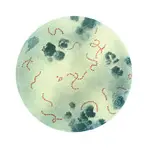Recurrent Streptococcal Pharyngitis in a Family

Established clients presented their dogs for streptococcal testing at the recommendation of the family physician.
HistoryThe family had been experiencing recurring streptococcal pharyngitis (ie, strep throat), and the physician advised that the dogs be tested and treated or removed as necessary. The owners presented a spayed bichon frise (3 years of age) and a castrated small crossbreed dog (10 years of age). At presentation, both were clinically normal.
Related Article: Recurrent Pyoderma in a Golden Retriever
What is the best approach?A. Collect pharyngeal swabs from both dogs and submit them for culture.B. Collect pharyngeal swabs from both dogs and give them to the clients for physician examination and analysis.C. Treat both dogs with amoxicillin.D. Inform the clients that dogs are not a possible source of infection.E. Coordinate with the family physician to provide a collaborative approach.
Correct AnswerE. Coordinate with the family physician to provide a collaborative approach.
Streptococcus pyogenes (ie, group A Streptococcus [GAS]) is a significant pathogen in humans, typically causing streptococcal pharyngitis and sometimes more severe widespread disease (eg, bacteremia, pneumonia, necrotizing fasciitis, toxic shock syndrome, puerperal sepsis). GAS carriage is also common in healthy humans, particularly children, and can be found in the throats of 15% to 20% of healthy school-age children.1 The potential role of pets in GAS infections in humans is sometimes discussed by physicians, and it is not uncommon for them to request animal testing.
A few older studies implicating animals as potential sources of GAS infection in humans used culture methods that we now know do not differentiate GAS from group G streptococci (eg, the canine commensal S canis)<sup.2,3sup> More recent studies have not identified GAS in companion animals, including those living with children with recurrent GAS infection.4,5 In fact, Infectious Diseases Society of America (IDSA; idsociety.org) guidelines recommend only testing human household contacts in specific situations and assert that no credible evidence supports that pets have a role in recurrent human infection.6 Testing is not indicated in this situation; however, discussion with the physician is important to ensure that the reasons for not testing are clear, to educate the physician about the issue, and to foster better communication between veterinarian and physician.
As awareness of zoonotic disease and concern regarding the role of companion animals in human infection grows, veterinarians increasingly encounter requests to test, treat, or even euthanize animals in response to human health problems. On occasion, testing is justified and important in identifying the source of infection. More often, it is an unnecessary or potentially misleading step with negative consequences. Therefore, when a veterinarian receives a client or physician request to test a healthy animal, the following questions should be considered:
Related Article: Limiting Legal Liability in Zoonotic Cases
Is there a reasonable chance that the organism will be found?This is a logical first step, as sometimes adequate data can indicate whether there is reason for concern. No credible reports support GAS colonization in dogs or dogs as a source of human GAS infection.
Can the laboratory adequately identify the organism?Veterinary and human diagnostic laboratories may not have the expertise to properly identify organisms that are rare in their respective patients. Isolation of GAS is relatively easy, but it is critical to ensure that the diagnostic laboratory can differentiate GAS from S canis.
Is isolation enough, or is typing required?Often, isolation of a bacterium only tells part of the story, and further testing is required to determine whether pet and person carry the same strain. Typing does not differentiate human-to-pet transmission, pet-to-human transmission, or common source infection, but it can provide useful information (see Point of Transmission). However, typing is rarely possible because human isolates may not have been saved or access to laboratories may be limited. This is less concerning when considering GAS testing because of the low likelihood that GAS would be present in a dog and, in the extremely unlikely event that it were found, it would be expected to be the same as the human isolate because it presumably came from an infected human household member.

Point of TransmissionFinding GAS in both human and dog would be very unexpected but strongly suggestive of human–dog transmission of this human-origin bacterium. The natural origins of a pathogen must be considered when evaluating zoonotic disease risks and testing results to avoid unnecessary expense, stress, and potentially unwarranted rehoming or euthanasia.
Streptococcus pyogenes bacteria at 900¥ magnification. Courtesy Centers for Disease Control & Prevention.
Is the whole household being addressed, or just the pet?Even if the dogs were potential sources of GAS infection, humans would remain the most likely reservoir in the household. In this situation, addressing only the dogs is illogical. If pets were a potential reservoir, testing them in parallel with testing and treating humans may be justifiable; however, if there is no concurrent effort to eradicate GAS from humans in the household, there is no indication to consider measures for dogs.
What would be done in response to a positive & negative result?With any screening measure or diagnostic test, there should be a plan on how to respond to positive versus negative results. If GAS is found in a pet and if similar treatment is administered to colonized humans, one could argue for treatment to eradicate GAS colonization from the animal; however, this is questionable as there is no evidence that pets are relevant sources of this human-associated bacterium.
Who will coordinate testing & response?Test coordination is important to ensure proper collection, testing, saving, or forwarding of bacterial isolates for typing (if indicated); ensure that human and animal data are considered in parallel; and ensure that the context of human and animal test results are accurately interpreted. Achieving these objectives requires joint physician and veterinarian involvement. The veterinarian needs to facilitate proper testing, interpret results from animal testing, understand the animal’s clinical condition, and direct any measures that might be required for the animal (eg, treatment). Simultaneously, the physician must ensure protection of human private medical history or, ideally, ensure that the patient has consented to the physician discussing the results with the veterinarian. This collaborative approach is essential and practical, yet uncommon because of poor communication between veterinary and human medicine.
The Take-Home
Companion animals can be a potential source of some infectious diseases, but they are not always the cause.
Understanding the biology and epidemiology of the microorganism is required for logical decisions regarding the testing and treatment of healthy pets.
Coordinating efforts between the veterinary and human medical fields, often involving veterinary and human infectious disease specialists, is the best way to ensure that a logical approach is followed.
Testing healthy animals for zoonotic pathogen carriage is rarely indicated.
J. SCOTT WEESE, DVM, DVSc, DACVIM, is a veterinary internist and microbiologist, chief of infection control at University of Guelph Ontario Veterinary College Health Sciences Centre, and Canada research chair in zoonotic diseases. Dr. Weese’s research foci are infectious and zoonotic diseases (particularly of companion animals), infection control, staphylococcal infections, Clostridium difficile infection, and antimicrobial therapy.